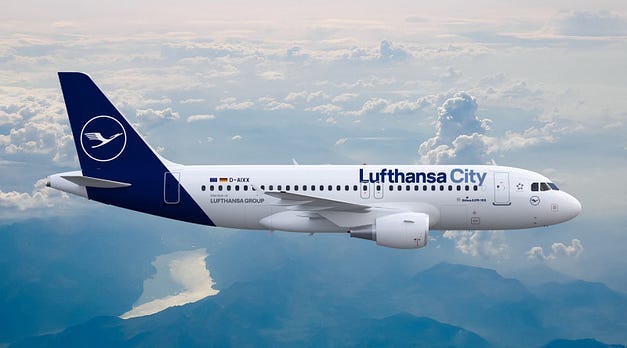Another day, another Lufthansa brand
But does this one actually make sense?
Lufthansa, Eurowings, Germanwings, Discover, Lufthansa Italia, and Lufthansa CityLine. What do all these brands have in common? They are all brands in Lufthansa stable. Quite a lot isn’t it?
What if I told you they just added another one?
Just last week I was writing about how happy I was when Lufthansa finally figured out their branding strategy. A week after that story was published, Lufthansa came out with yet another brand: Lufthansa City.
But why?
Not to be confused with the current Lufthansa Cityline, a feeder airline that operates out of Munich and Frankfurt, Lufthansa announced yesterday that City Airlines will launch in 2024 and operate alongside CityLine as a feeder airline from Munich and Frankfurt. Yes you read that correctly. It’s essentially CityLine 2.0.
This time Lufthansa is trying hard NOT to dilute the Lufthansa brand. From the livery (which looks like it was hastily put together with photoshop signs everywhere), it is meant to give passengers the impression of Lufthansa, and it does. No passenger will notice the small “City” titles, it’ll be like they are boarding a Lufthansa flight. And unlike Eurowings which has their own separate product, Lufthansa says the product will more or less be line with mainline Lufthansa service, it’s even possible to earn and redeem Lufthansa miles, making it a seamless experience.
So why not just use Lufthansa crew?
To answer this question, we need to look at the airline it will operate alongside and eventually absorb: Lufthansa CityLine. Currently the airline is allowed to operate aircraft of any size, but from 2026 CityLine will be restricted to operate aircraft under 95-seats.
No doubt Lufthansa is looking ahead. From a business perspective, to expand with aircraft of this size is limiting. City Airlines will launch with Airbus A319 and plans to expand with Airbus A220 or Embraer E2 jets, both of which are over the 95-seat limit. With this move, Lufthansa is positioning a new feeder airline as a precautionary means on to circumvent this clause when it comes into effect in 2026.
However, where things get interesting is the following quote from Jens Fehlinger, Managing Director of City Airlines:
With City Airlines, we want to create prospects for the coming decades and secure sustainable jobs in Germany. This is the only way for us to grow and sustainably strengthen the hubs in Munich and Frankfurt
No, City Airlines is not going to operate a sustainable aircraft fuel only fleet. If you read between the lines, they want sustainability in terms of jobs, ie. Cheaper labor. Note that while service on-board would be similar to Lufthansa mainline, crew on City will be employed under a different contract, most likely tailored for a feeder airline which in turn could cut costs for Lufthansa.

It is also clear that Lufthansa is trying to woo over pilots from CityLine with the following quote from the press release:
For Group employees interested in switching to City Airlines, offers with voluntary switching conditions can be negotiated. This includes Lufthansa CityLine staff in particular.
Yup, you cannot be any more direct. They hope CityLine pilots can fly for City at similar salaries but with bigger aircraft instead.
It’s clear Lufthansa is looking ahead. Air Dolomiti will soon disappear along with CityLine together with its aircraft limiting clause. Employees will slowly be shifted to similar contracts and fly for City Airlines.
I cannot help but feel Lufthansa is being ever so slightly sneaky with this move. Mainline crew will end up flying long haul routes more often while City Airlines crew will focus on short-haul routes and a lower cost base. Theoretically this could mean lower priced tickets for passengers, but we know that airlines will most likely reap the benefits themselves.
Lufthansa is a big airline and they could just absorb all the feeder routes themselves. This option may not be financially viable in the long run though. To counter this, they set up a separate brand that can offer them best of both worlds: a uniform Lufthansa experience at a lower cost to the airline.
While this branding sounds more like a necessity rather than Lufthansa having nothing else better to do, I can appreciate this branding more than some of Lufthansa’s previous ventures. Lufthansa carefully navigated through a tricky situation of limited future growth by creating a brand similar to the mainline whilst still creating a uniform passenger experience without diluting the brand.
Only time will tell if this strategy will be successful. Initially, I thought Lufthansa must be joking with such another brand and I had my doubts as to whether I like this brand. However, after analysing the above, I find myself in the strange position of commending Lufthansa with a boring yet strategic branding move.

